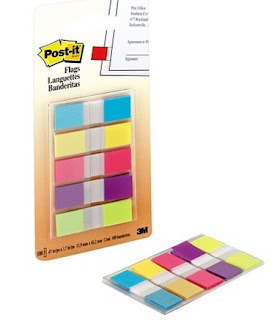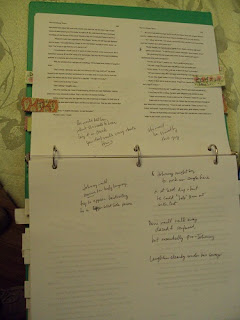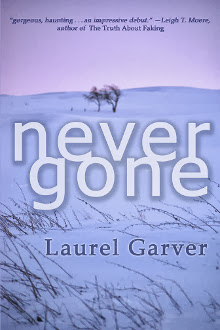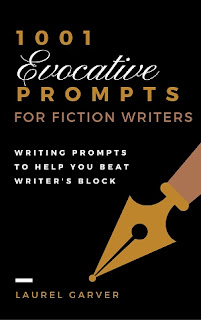Once you have a manuscript that's complete, you can try to identify weaknesses yourself, after you've set the manuscript aside for a while. Or you can ask a few readers to give it a look. I've done both before digging into a full revision.
Your goal is to identify a set of major threads--perhaps character arcs or plots--that need to be shored up or perhaps re-conceived. Between reader feedback and my own re-reading of sections and scenes they identified as somehow lacking, I came up with four major threads. With this knowledge, I next do the following:
Gather supplies
I find it helpful to work with a printed version of my manuscript. It's easier to navigate than an electronic one and I'm less likely to end up with version confusion if I do the messiest marking up on a physical copy. For my method, you need
The manuscript printed, two pages per sheet (see example below)
 |
| A three-ring binder |
 |
| A three-hole punch |
 |
| Post-it flags |
Flag and list
Prepare your manuscript by hole-punching the pages and inserting them in the binder. I prefer the ring at the bottom of the page, with the back of the previous page as note jotting space. But punching the top would work as well, with note jotting space above.
Assign a colored flag to each of the revision threads you will be tackling. (I happened to have patterned ones, but plain, as shown above, work great too. Color coding is the key.)
Open a new document in Word and list the major threads. This will be where you keep a record of all your concerns, ideas and plans: a revision running list.
 |
| I like using the space below to jot notes. |
Flag the scene with the appropriate colored flag. Jot a note in the margin or on the adjacent page about what's bothering you.
In your running list Word document, under the appropriate thread,
~List the page where you see the opportunity.
~Describe what isn't working.
~Brainstorm possible solutions.
~Jot down dialogue or descriptions that occur to you
If ideas to fix later scenes involving the same thread occur to you as you read earlier scenes, describe them in your running list under the appropriate thread. When you eventually get to those scenes in the read-through, add flags to the pages and page numbers to your running list.
As much as possible, try to tackle this identification process in a linear manner, progressing from the beginning to the end of the story. Otherwise, you risk missing minor details that affect your revision threads and need to be changed.
Resist the urge to actually fix any of the problems. Simply list them. If you have a perfect solution, add it to the running list.
Conversely, if you don't have a solution, there's no pressure. You're aware of the issue and can come back to it later. Perhaps once you've tackled other things, a solution will come to you
Revise your manuscript
Print out your complete running list.
Tackle any revision you clearly know how to fix. Then remove the colored flag from that page in your notebook, and check it off your running list. (I find it helpful to also use strike-through on the electronic version of my running list as a back up, because I may end up adding to the list as I actually do the revisions.)
Move on to the more and more difficult revisions and rewrites. If any revision will affect a later problem scene, add the information about what changes to your running list.
Continue until you've removed all the flags and crossed off everything on your list.
Print a fresh copy of your story. Set it aside for a few days.
Read through it aloud. Mark rough transitions, voice issues, repetition, echoes, wordiness, and typos.
Make those corrections.
Pass the manuscript off to beta readers or your editor, depending on how confident you feel after your copy-editing read.
How do you typically tackle revisions?









This is almost exactly how I revise, but I love your idea of printing two pages per sheet of paper--that leaves such a nice, accessible blank space for notes! I end up squeezing mine into margins and between paragraphs.
ReplyDeleteThanks for the tip!
The type is fairly small this way, but I'm used to it. One of my CPs alerted me to the choice in Word's print menu, mostly as a way to save paper, but that big margin at the bottom is pretty great.
DeleteGreat tips, thanks! My method is a little looser than that, yours gives me food for thought.
ReplyDeleteI've found that if I don't stay organized, I end up doing far more versions and it takes me longer.
DeleteGreat post on editing! I never thought of printing the manuscript in landscape format with two columns. I bet seeing it differently really helps. I'll have to give that a try.
ReplyDeleteThe print is pretty small this way, but it saves paper, and I do find it defamiliarizes the text enough that I catch more missing words (my particular foible).
DeletePrinting it up and marking it up like this seems like a GREAT way not to miss those important little threads, as well as starting at the beginning and working to the end with the revisions. Super ideas! and so organized!
ReplyDeleteThanks. I find that this way I can hop around when it comes time to actually doing the changes and still keep track of everything. Because some changes are easier to make than others! Often doing the easy ones first helps the ideas to bubble up on how to repair the tougher changes.
Delete